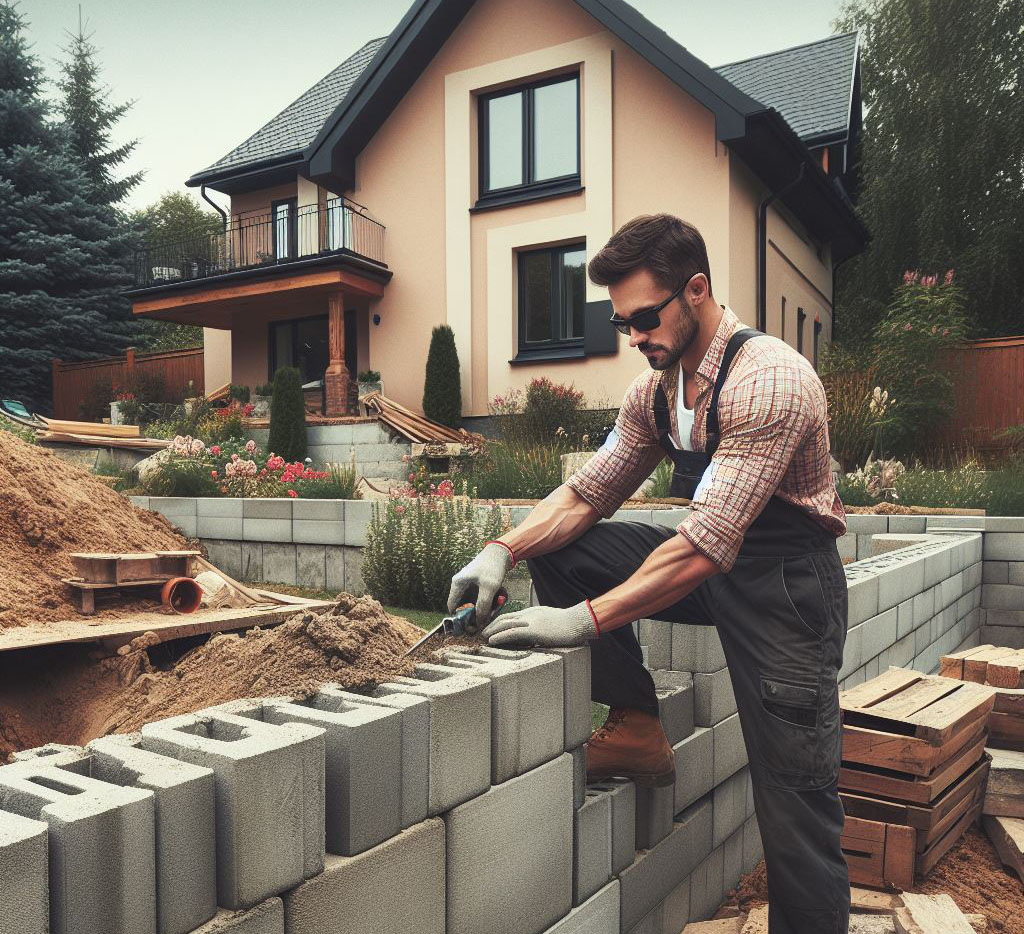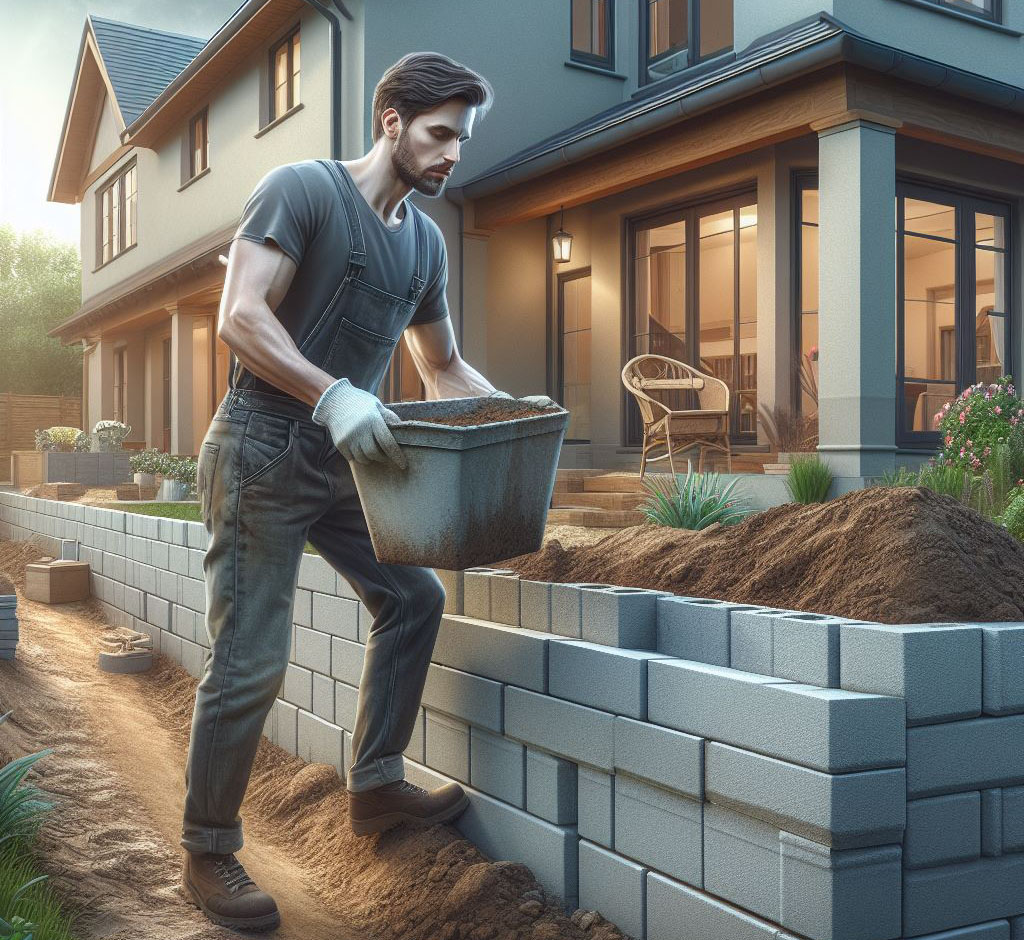In the realm of landscaping, the retaining wall emerges as a pivotal element, often overshadowed in discussions yet crucial in function and form. This structure is not merely about resisting soil pressure, it’s an integral part of the landscape’s aesthetic and structural integrity. For those with a penchant for DIY projects and the frugal finesse of seasoned handymen, the retaining wall presents an opportunity—a canvas to marry practicality with visual appeal, all while adhering to a budget.

Understanding Retaining Walls
The essence of a retaining wall lies in its function: a steadfast ally against the forces of erosion and gravity, crafted to maintain the delicate balance of your landscape. Materials are chosen with a discerning eye—from the organic allure of timber to the steadfastness of concrete blocks and the innovative use of recycled elements. Each material speaks to a specific narrative of durability, cost, and aesthetic, culminating in a structure that not only holds back earth but also blends harmoniously with its natural surroundings.
Inexpensive Materials for Retaining Walls
Navigating the cost-effective route in construction doesn’t imply a compromise on quality or aesthetics. It’s about making informed, resourceful choices:
- Timber: A testament to time, timber brings a natural warmth to any structure. Opt for pressure-treated varieties to ensure longevity and resilience against the elements.
- Concrete Blocks: Robust and reliable, these are the linchpins in the world of retaining walls. Their affordability and versatility make them a go-to choice, especially when one keeps an eye out for deals or surplus from larger projects.
- Recycled Materials: Embrace the ethos of sustainability with recycled options. Materials like repurposed concrete or even discarded bottles can transform into an eco-friendly, visually intriguing retaining wall.
A tip for the budget-conscious: Local markets and construction sites can be treasure troves for materials at a fraction of the cost, sometimes even free. It’s a win-win for your pocket and the planet.

DIY Retaining Wall Designs
Crafting a retaining wall is akin to orchestrating a delicate dance between materials and the landscape. Here’s how to ensure your structure stands proud and functional:
- Plan and Prep: Know your terrain. Meticulous planning and preparation pave the way for successful execution, especially when it comes to drainage and soil dynamics.
- Solid Foundation: Every great structure starts with a solid base. A trench filled with compacted gravel sets the stage for stability.
- Lay it Right: Whether you’re working with bricks, blocks, or timber, remember the golden rule: stagger the joints, ensure proper alignment, and anchor your materials firmly.
- Backfill Basics: Proper drainage is the unsung hero of any retaining wall. Backfilling with gravel as you build up ensures that water doesn’t become an unseen adversary.
Creative Ideas for Retaining Walls
Retaining walls need not be purely functional, they can also be a testament to craftsmanship and aesthetic vision. Here’s how you can transform a simple wall into a standout feature of your landscape:
- Block Wall Ideas: Explore the artistic potential of cinder blocks by integrating color or embedding stones or soft lights within their hollows for an enchanting nighttime effect. Consider varying the block sizes or introducing curves in your design, adding a dynamic and visually engaging element to the otherwise straight lines.
- Brick Retaining Wall Ideas: Patterns can elevate a simple brick wall. Experiment with herringbone or basketweave patterns to bring a touch of sophistication. Color variations in bricks can add depth and character to your wall. Blend different shades to create a wall that’s not just structural but also a focal point.
- Landscape Wall Ideas: Walls can be more than barriers, they can be life-giving structures. Incorporating planters or creating tiers can introduce greenery, adding life and vibrancy. Tiered designs not only add a visual dimension but also offer practical planting solutions, enhancing the overall aesthetics of your garden.
- Retaining Wall Block Ideas: Mosaic patterns with blocks of varying sizes and colors can transform your wall into a piece of art. Inserting elements like pebbles or colored glass between blocks can add a unique, artisanal touch.
Maintenance and Upkeep
Like any well-crafted structure, retaining walls require attention and care to ensure their longevity and stability:
- Regular inspections are key. Keep an eye out for signs of movement, such as cracks or bulging, which might indicate structural issues.
- Cleanliness is not just aesthetic. Algae and mildew, if left unchecked, can compromise the wall’s integrity over time.
- Drainage is paramount. A well-drained wall is a happy wall. Incorporate adequate landscaping drainage solutions like gravel backfill and weep holes to prevent water build-up.
- Vegetation control is crucial. Overgrown plants can lead to structural issues, so regular pruning is necessary to maintain the wall’s integrity.
FAQ Section
While timber is cost-effective and has a natural appeal, consider cinder blocks or recycled concrete for a balance of affordability and durability.
For DIY projects, a height of 3-4 feet is advisable. Beyond that, professional input is recommended for structural integrity and compliance with local regulations.
Absolutely, but it requires careful planning. Step the wall to conform to the slope and ensure proper drainage to counter the gravitational forces.
Good drainage is crucial. Use a layer of gravel behind the wall and consider a French drain or weep holes to prevent water accumulation.
Personal touches can make all the difference. Consider painting, adding decorative lighting, or integrating plant life to elevate the wall’s aesthetic appeal.
